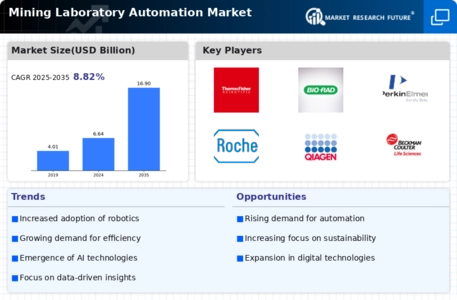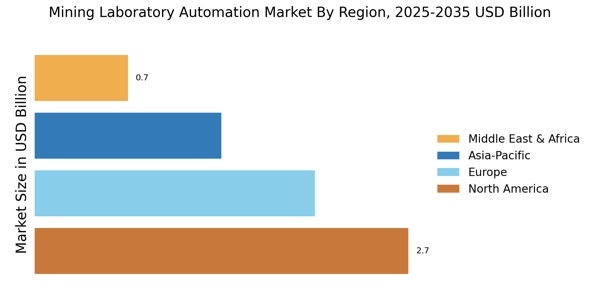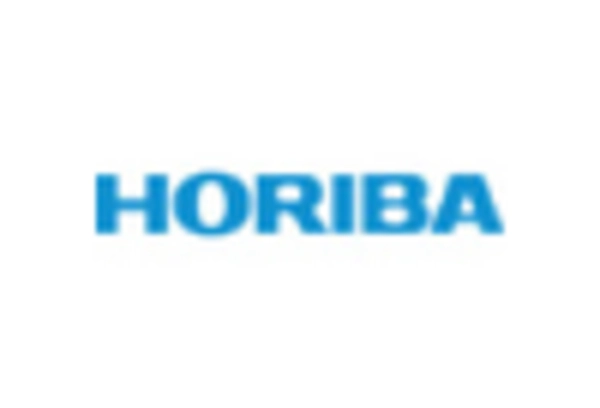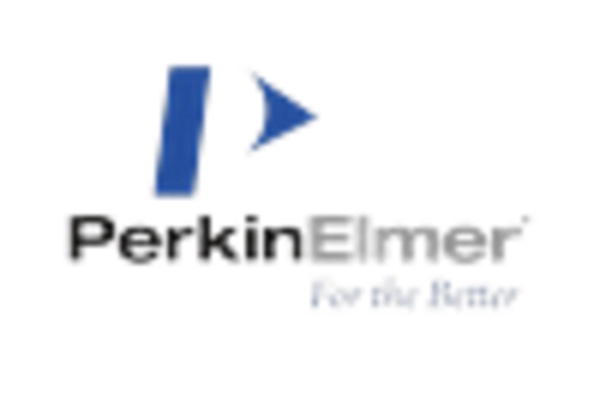Increased Focus on Data Analytics
The Mining Laboratory Automation Market is increasingly focusing on data analytics, as organizations seek to leverage data for informed decision-making. Advanced analytical tools integrated into automated systems allow for real-time data processing and interpretation, enabling laboratories to derive actionable insights from their operations. This trend is particularly relevant in the context of mining, where data-driven decisions can significantly impact exploration and production outcomes. The market for data analytics in laboratory automation is expected to grow substantially, with projections indicating a potential increase of 8% in the coming years. As mining companies strive to enhance their operational efficiency and reduce costs, the integration of sophisticated data analytics into laboratory automation systems is likely to become a key driver of growth in the Mining Laboratory Automation Market.
Technological Advancements in Automation
The Mining Laboratory Automation Market is experiencing a surge in technological advancements, particularly in automation technologies. Innovations such as robotics, artificial intelligence, and machine learning are transforming laboratory processes, enhancing efficiency and accuracy. For instance, automated sample analysis systems can process thousands of samples daily, significantly reducing turnaround times. This shift towards automation is not merely a trend; it is becoming a necessity for laboratories aiming to remain competitive. The market for laboratory automation is projected to grow at a compound annual growth rate of approximately 7.5% over the next five years, indicating a robust demand for automated solutions in mining laboratories. As companies seek to optimize operations and reduce human error, the integration of advanced automation technologies is likely to play a pivotal role in shaping the future of the Mining Laboratory Automation Market.
Regulatory Compliance and Safety Standards
In the Mining Laboratory Automation Market, adherence to regulatory compliance and safety standards is increasingly critical. Laboratories are required to meet stringent regulations concerning environmental impact, worker safety, and data integrity. Automation technologies facilitate compliance by providing precise data tracking and reporting capabilities, which are essential for meeting regulatory requirements. For example, automated systems can ensure that all processes are documented and traceable, thereby reducing the risk of non-compliance. The demand for automated solutions that enhance safety and compliance is expected to drive market growth, as companies prioritize investments in technologies that mitigate risks associated with manual processes. This focus on regulatory compliance is likely to propel the Mining Laboratory Automation Market forward, as organizations seek to align with evolving standards and practices.
Growing Investment in Research and Development
Investment in research and development is a crucial driver for the Mining Laboratory Automation Market, as companies seek to innovate and improve their laboratory processes. Increased funding for R&D initiatives allows for the exploration of new technologies and methodologies that can enhance automation capabilities. This trend is evident in the rising number of partnerships between mining companies and technology providers, aimed at developing cutting-edge automated solutions. The market is expected to benefit from this influx of investment, with estimates suggesting a growth rate of approximately 5% in R&D spending related to laboratory automation. As organizations prioritize innovation to stay ahead of the competition, the Mining Laboratory Automation Market is likely to see a proliferation of advanced technologies that streamline laboratory operations and improve overall efficiency.
Rising Demand for Efficient Resource Management
The Mining Laboratory Automation Market is witnessing a rising demand for efficient resource management, driven by the need to optimize operational costs and improve productivity. Automation solutions enable laboratories to manage resources more effectively, from sample handling to data analysis. By minimizing waste and maximizing throughput, automated systems contribute to a more sustainable approach to mining operations. The market is projected to see a significant increase in the adoption of resource management technologies, with estimates suggesting a growth rate of around 6% annually. This trend reflects a broader industry shift towards sustainability and efficiency, as companies recognize the importance of resource optimization in maintaining competitiveness. As such, the Mining Laboratory Automation Market is likely to benefit from innovations that enhance resource management capabilities.


















Leave a Comment